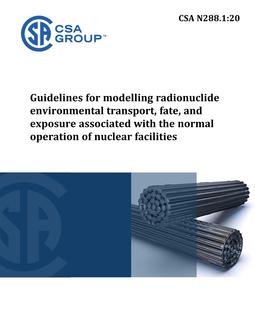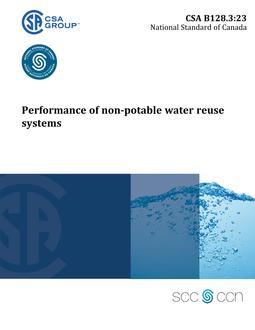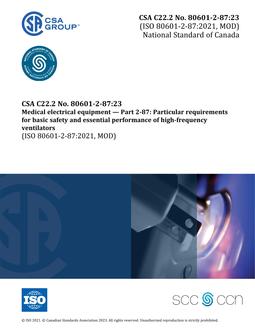
CSA N288.1:20
Click here to purchase
Preface:
This is the fourth edition of CSA N288.1, Guidelines for modelling radionuclide environmental transport, fate and exposure associated with the normal operation of nuclear facilities. It supersedes the previous editions published in 2014, 2008, and 1987 under the title, Guidelines for calculating derived release limits for radioactive material in airborne and liquid effluents for normal operation of nuclear facilities.
Major changes to this edition include
a) updated the structure of these Guidelines for increased consistency within the CSA N288 series;
b) removed administrative language from the Guidelines;
c) provided additional clarification in areas identified by users;
d) identified stable carbon data for aquatic plants and invertebrates;
e) improved consistency of language throughout the Guidelines; and
f) updated the guidance on transfer factors.
The COG background document (Hart, 2013) was revised in concert with the fourth edition; the updated version is referred to hereafter as the COG Derived Release Limits Guidance or CDG (Hart, 2019).
Users of these Guidelines are reminded that the site selection, design, manufacture, construction, installation, commissioning, operation, and decommissioning of nuclear facilities in Canada are subject to the Nuclear Safety and Control Act and its Regulations.
The CSA N-Series Standards provide an interlinked set of requirements for the management of nuclear facilities and activities. CSA N286 provides overall direction to management to develop and implement sound management practices and controls, while the other CSA Group nuclear Standards provide technical requirements and guidance that support the management system. These Guidelines work in harmony with CSA N286 and do not duplicate the generic requirements of CSA N286; however, they may provide more specific direction for those requirements.
Scope:
1.1 Facilities
These Guidelines and the CDG are intended to apply to CANDU nuclear power stations in Canada. However, the radionuclides and environmental pathways addressed make these Guidelines applicable to releases from many other nuclear facilities, including research reactors, radioisotope processing facilities, waste processing facilities such as incinerators, and power reactors other than those of CANDU design, subject to the limitations detailed in Clauses 1.2 to 1.8. Application to other types of facilities such as fuel fabrication plants and refineries is limited by the radionuclides considered here (see Clause 4.3). These Guidelines may be adapted to cover part of the needs of such facilities, but additional models or methodologies might be necessary for other parts. However, neither the radionuclides nor the models included in these Guidelines are complete enough to cover releases from sources such as uranium mines and mills, or permanent geologic disposal facilities. In addition, the pathways are incomplete for any facilities where extensive modelling of groundwater pathways is required.
1.2 Release paths
These Guidelines cover releases to the atmosphere and to surface water (both fresh and marine). They do not address releases to groundwater, although transfers from other media to groundwater wells and ponds are considered. Direct gamma irradiation from radioactivity inside the facility is not modelled because it does not involve a release.
1.3 Release duration
The methods specified in these Guidelines are designed for routine, continuous, low-level emissions. They also apply to periodic, short-term releases (see Clause 8.2), provided that
a) the releases are controlled and associated with normal operations;
b) the release rate is roughly the same from event to event;
c) for atmospheric releases, the total release duration exceeds approximately 1000 h in the year; for aquatic releases, at least one or two releases occur in each month of the year; and
d) the releases occur randomly over time.
Where the requirement of Item d) is not met but the releases are known to occur at a particular time of day or year, these Guidelines apply only if the air (water) concentrations are calculated using the meteorological (hydrological) data in effect for that time.
Notes:
1) Where non-random releases are calculated using time-appropriate data, it might be possible to relax the conditions on the release frequencies.
2) Releases that do not meet these conditions can use another model, such as that specified in CSA N288.2 for atmospheric releases.
3) For some facilities, intermittent releases occur predictably as spikes on a continuous base release. Such releases can be considered part of routine emissions and included in the DRL without special treatment if the total activity released in intermittent form is less than approximately 30% of the total release from the facility. The 30% cut-off is considered a small fraction of the overall uncertainty of the DRL estimates.
1.4 Contaminants
These Guidelines apply to the radiation effects of radionuclides. They do not apply to chemicals or to the chemical toxicity of radionuclides.
1.5 Receptors
The model can be used to calculate doses or derive release limits for a representative person having the average characteristics of a group of individuals who, by reason of their location and habits, are likely to receive the highest exposures to a given radionuclide released from a particular source (see Clause 4.2). These Guidelines do not apply to nuclear energy workers (NEWs), or to non-NEWs working at a nuclear facility, who are assumed to be covered by on-site radiation protection programs. The DRLs calculated using the models specified in these Guidelines apply to human receptors only; however, the models can be used to support dose calculations for non-human biota.
1.6 Downwind distance of validity
These Guidelines are not applicable to receptors located close to a source affected by building-induced turbulence because the atmospheric dispersion model does not simulate the cavity that forms in the lee of the building. Because the cavity extends approximately three building heights downwind, these Guidelines apply only beyond this distance. Moreover, the dispersion model should be used with caution beyond an approximate distance of 20 km from the facility because the assumption of steady-state meteorological conditions implicit in the model becomes less valid at greater distances. This is not an issue in practice because the representative person is usually found closer to the facility than 20 km.
1.7 Site specificity
Local parameter values should be used wherever possible when applying models to a specific site. Where local values are not available, the default values given in these Guidelines for the region closest to the site of interest may be used. These regional values represent conditions at the main nuclear sites in Canada (i.e., Pickering/Darlington, Bruce, CRL, G-2, and Point Lepreau) but may be interpreted as default values for the regional areas of southern Ontario, western Ontario, eastern Ontario, Quebec, and the Maritimes, respectively. Some items which make sites unique are: topography (e.g., escarpment, river valley, lake effect), proximity to water bodies, prevalent wind patterns, and surface roughness.
1.8 Level of complexity
1.8.1 Simpler approaches
The models specified in these Guidelines are comprehensive and in some cases include considerable detail. This level of complexity might not be warranted for all assessments. Less complex approaches, involving fewer pathways and/or less detail, might be appropriate under some circumstances. Any pathway that can be shown to not contribute significantly to the total dose may be neglected. In these cases, simpler models such as those described by the IAEA Safety Report Series No. 19 may be used, provided that justification for using a simpler approach is provided.
Note: For example, the following need not be considered:
a) radionuclides that are not released from the site of interest; and
b) pathways related to wells that are not used as a source of water by members of the public near the site.
1.8.2 Default transfer parameters
A simplified approach is available for application of these Guidelines without implementation of the models. Annex A lists default transfer parameters for each radionuclide for each pathway in the model, together with the assumptions made in calculating the values. If the assumptions hold for the application in question, these default values may be used to obtain estimates of the DRLs without implementing the model itself, as demonstrated in Annex B. This allows all of the models and parameter values in these Guidelines to be accessed in a simple way. Because conservative assumptions were made in calculating the default parameter values, the DRLs calculated using this approach will be more conservative than those obtained by implementing the model.
The default transfer parameters can also be applied to conduct an initial assessment, combined with a sensitivity analysis, to determine which pathways or radionuclides merit further efforts to reduce model uncertainty through the application of site-specific measurements (see CDG, Appendix J).
1.9 Terminology
In these Guidelines, “should” is used to express a recommendation or that which is advised but not required and “may” is used to express an option or that which is permissible within the limits of the Guidelines.
Product Details
- Edition:
- 4th
- Published:
- 03/01/2020
- ISBN(s):
- 9781488325793
- Number of Pages:
- 476
- File Size:
- 1 file , 4.6 MB
- Product Code(s):
- 2427651, 2427651


